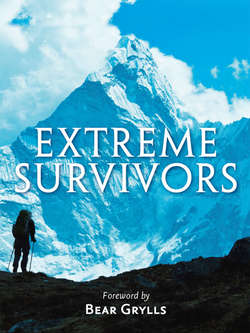Читать книгу Extreme Survivors: 60 of the World’s Most Extreme Survival Stories - Collins Maps - Страница 62
ОглавлениеA Rock and a Hard Place
| A LONE CLIMBER IS TRAPPED BY A FALLING ROCK IN THE DESOLATE CANYONS OF UTAH. AFTER FIVE DAYS OF DEHYDRATION, STARVATION AND HALLUCINATIONS, HE MAKES THE DECISION TO CUT OFF HIS OWN RIGHT ARM WITH A PENKNIFE TO FREE HIMSELF FROM THE BOULDER. ONCE FREE HE STILL HAS TO ABSEIL AND WALK HIS WAY BACK TO SAFETY. |
| DATE: 2003 SITUATION: CLIMBING ACCIDENT CONDITION OF CONFINEMENT: TRAPPED BY A FALLEN ROCK DURATION OF CONFINEMENT: 5 DAYS MEANS OF ESCAPE: CUTTING OFF HIS OWN RIGHT ARM WITH A PENKNIFE NO. OF ESCAPEES: 1 DANGERS: STARVATION, DEHYDRATION, BLEEDING TO DEATH EQUIPMENT: PENKNIFE |
Canyonlands National Park, Utah.
Loner’s day out
He wanted to be alone for this adventure, that much was certain. When Aron Ralston set out from home in Aspen, Colorado, he told no one where he was going. It’s common climbing practice to leave a route either with friends or on a piece of paper in your car. Ralston did neither. As an experienced climber he should have known better.
Nature is king in Canyonlands. Rain, river and wind have spent millennia gouging out deep, twisting canyons from the flat desert plateau. Like veins, they offer a route through the wilderness. Like veins they are also hidden from view, lying below the surface of the plateau. It’s a weirdly beautiful but also dangerous place: get stuck in a lost corner of a canyon and there is no reason why another human being would find you for days, months or years. If at all.
It was Saturday 26 April 2003 and Ralston had selected a particularly isolated part of what is already a remote area. His plan was to park at Horseshoe Canyon and mountain bike 24 km (15 miles) to Bluejohn Canyon. Bluejohn was the favoured hideout spot of Butch Cassidy and the Sundance Kid; its remoteness is one of its defining characteristics.
‘It was amazing that he was walking on his own, losing as much blood as fast as he was.’
He would then scramble and climb through the narrow ravine and hike back round to his pickup. By his standards, it wasn’t a particularly big day. Ralston, 27, was a keen outdoorsman and climber. He had already climbed forty-nine of Colorado’s fifty-five peaks over 4,300 m (14,000 ft), forty-five of them solo in winter. This outing was just a warm-up for a greater challenge: an ascent of North America’s highest mountain, 6,195 m (20,320 ft) tall Mount McKinley.
Ralston had packed accordingly. All he had in his rucksack were two burritos, a litre (½ pint) of water, a cheap Leatherman-like multi-tool, a small first aid kit, a video camera, a digital camera and some climbing equipment. He was wearing just a T-shirt, shorts and baseball cap and had no spare clothing.
The accident
Ralston pedalled across the desert to the canyon trailhead and secured his bike to a juniper tree. He began ‘canyoneering’ down the sinuous ravine. This technique uses elements of climbing, scrambling, jumping and skidding as well as technical ropework – anything that will get you through the canyon.
It was just before lunchtime and Ralston had traversed most of the canyon. When he was just 150 m (492 ft) from the final abseil out of the canyon, he came into a 0.9 m (3 ft) wide crack. Like many of the smaller ravines it had boulders wedged in it. Most of these are stuck fast, jammed there for centuries. But the elements are constantly rearranging the desert, and many stones will rock or slide when moved.
